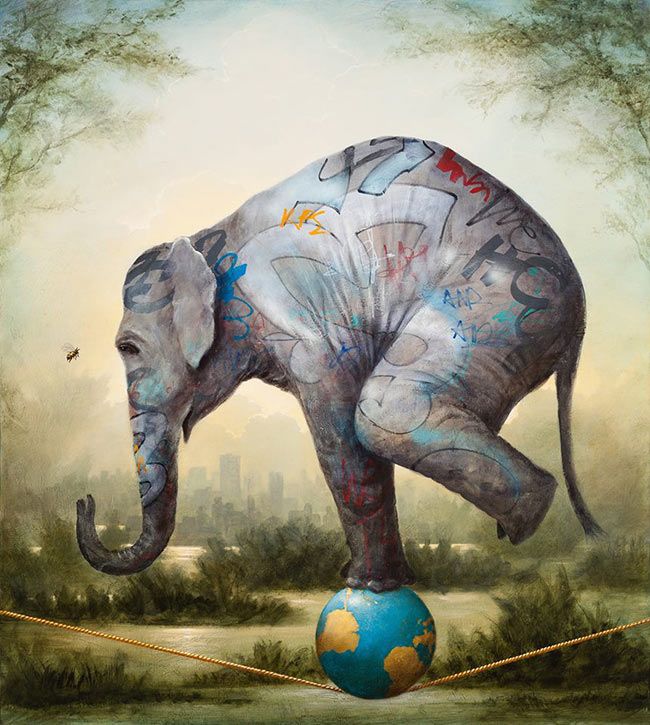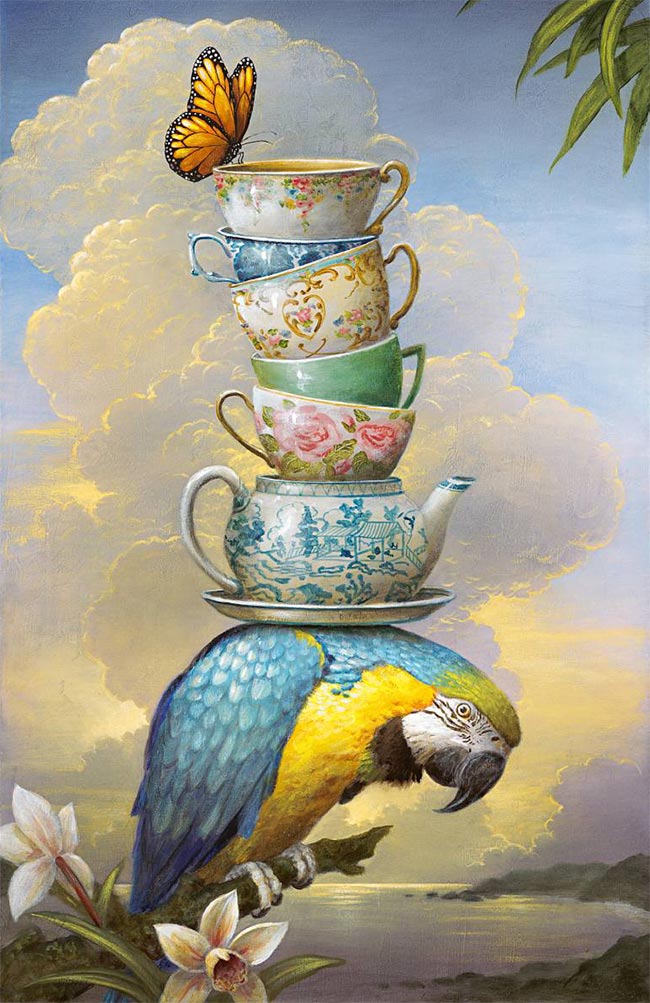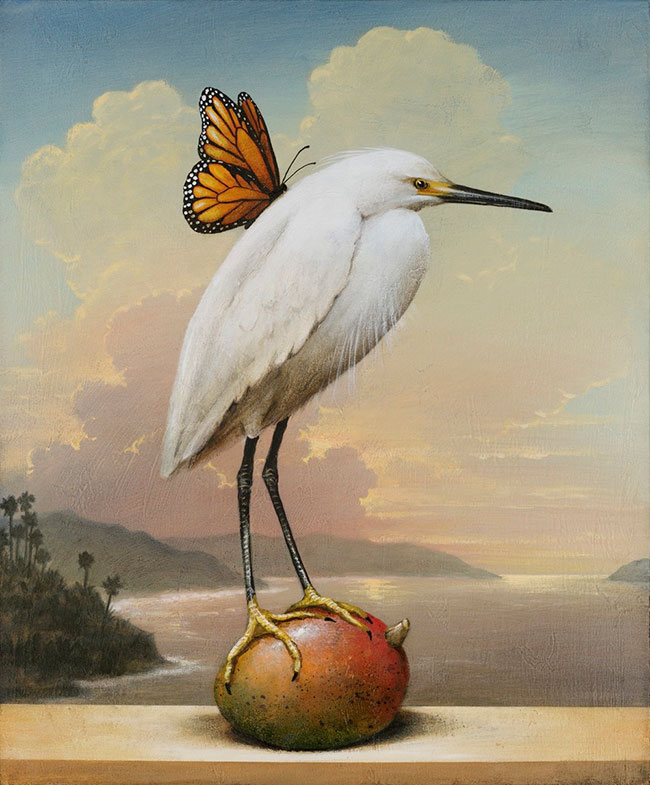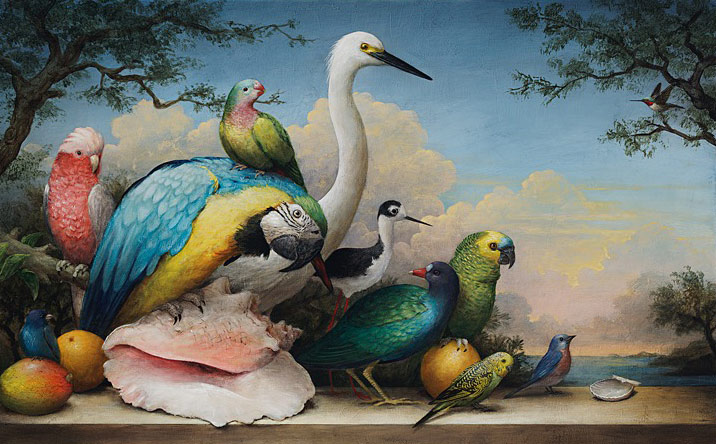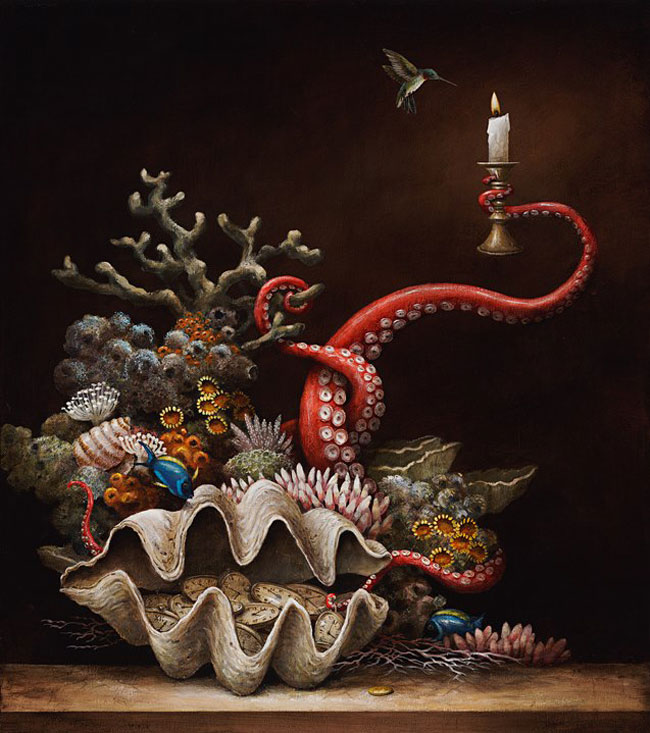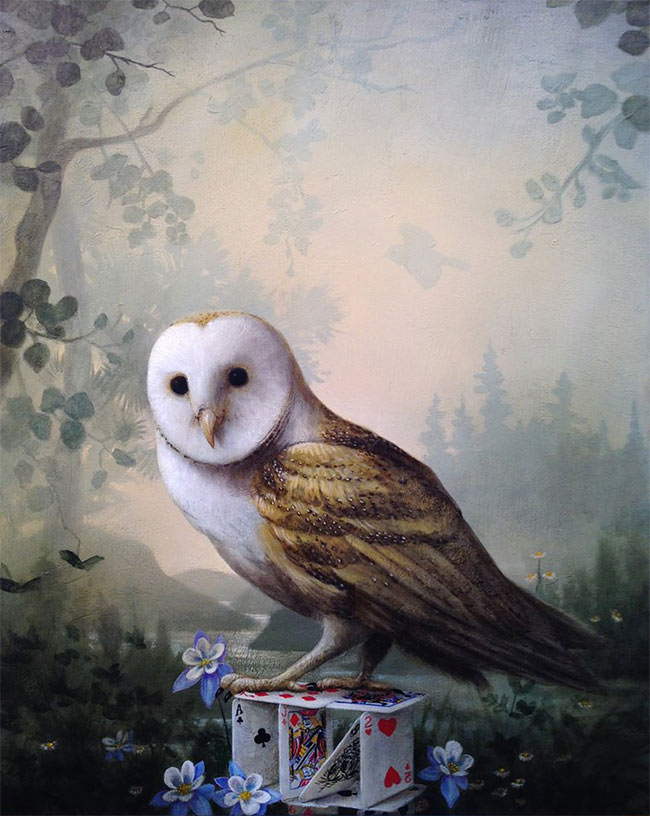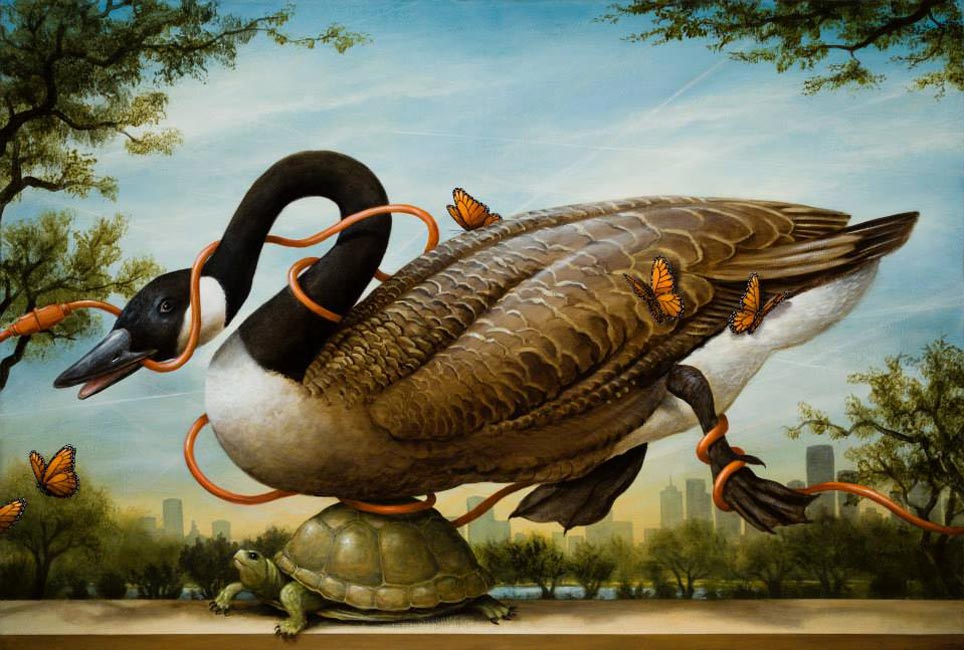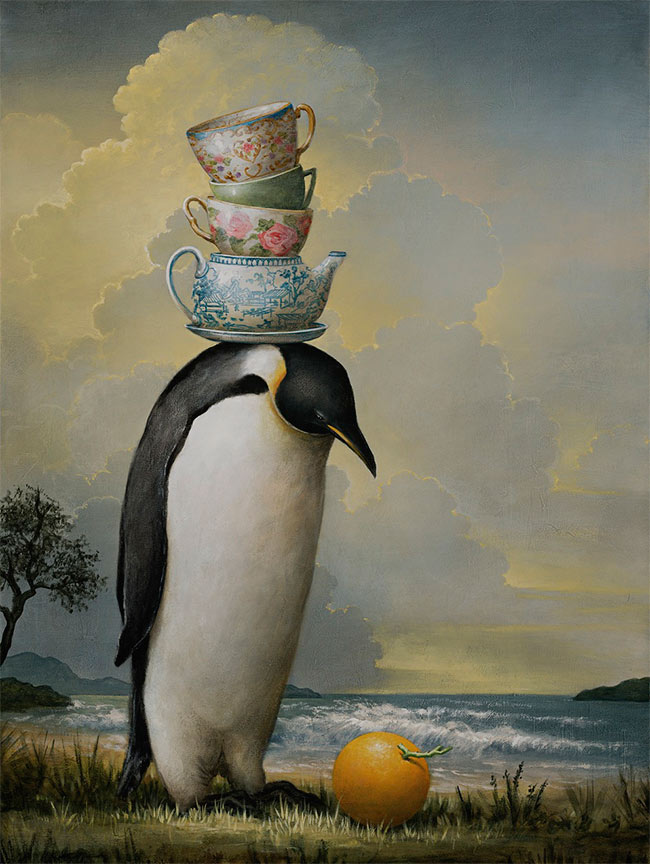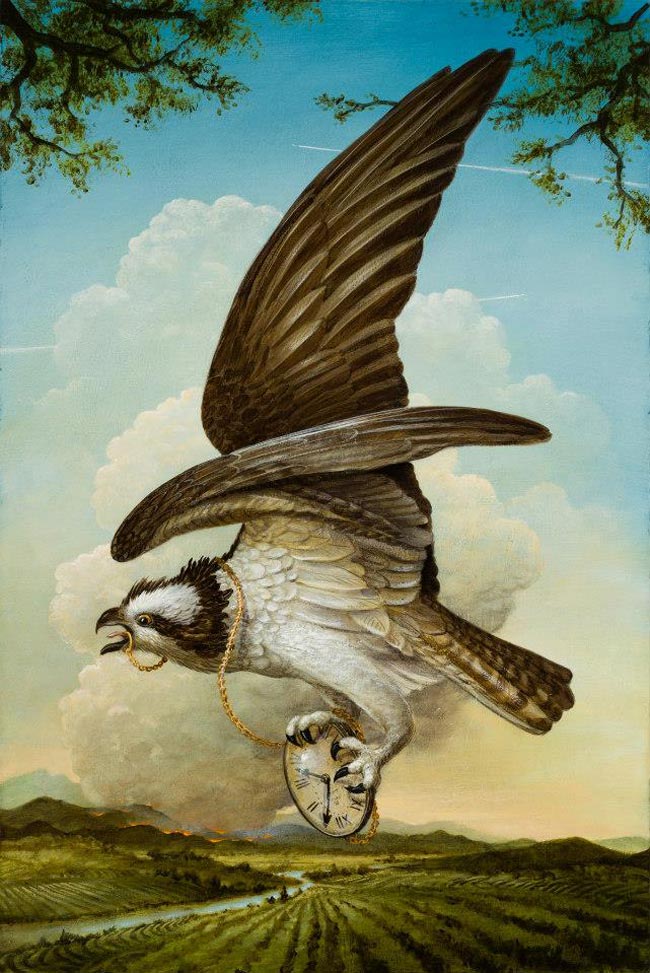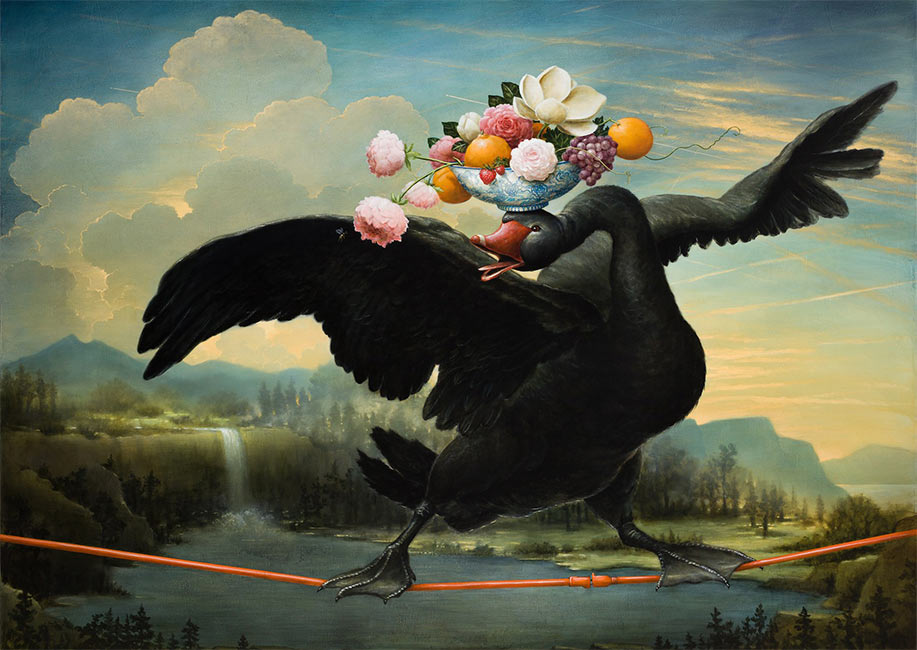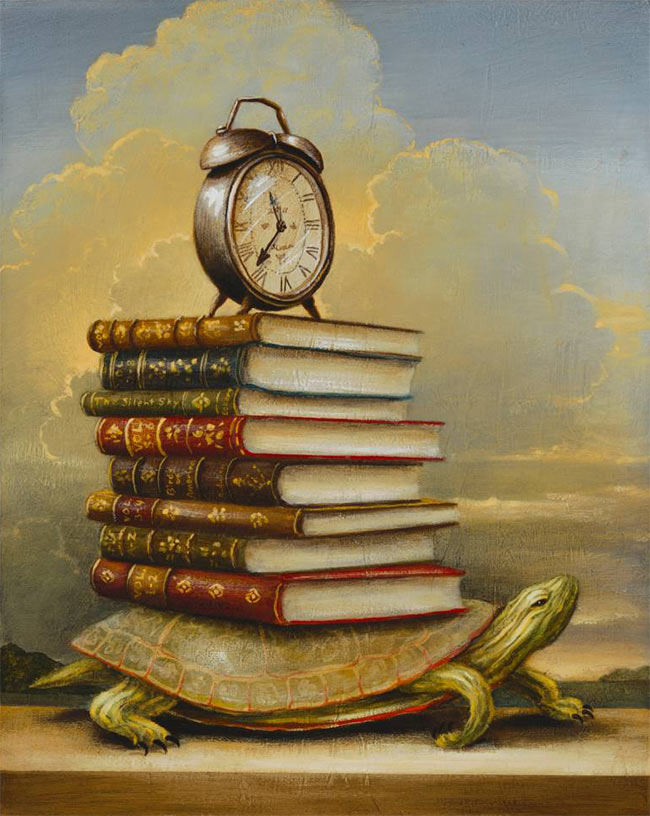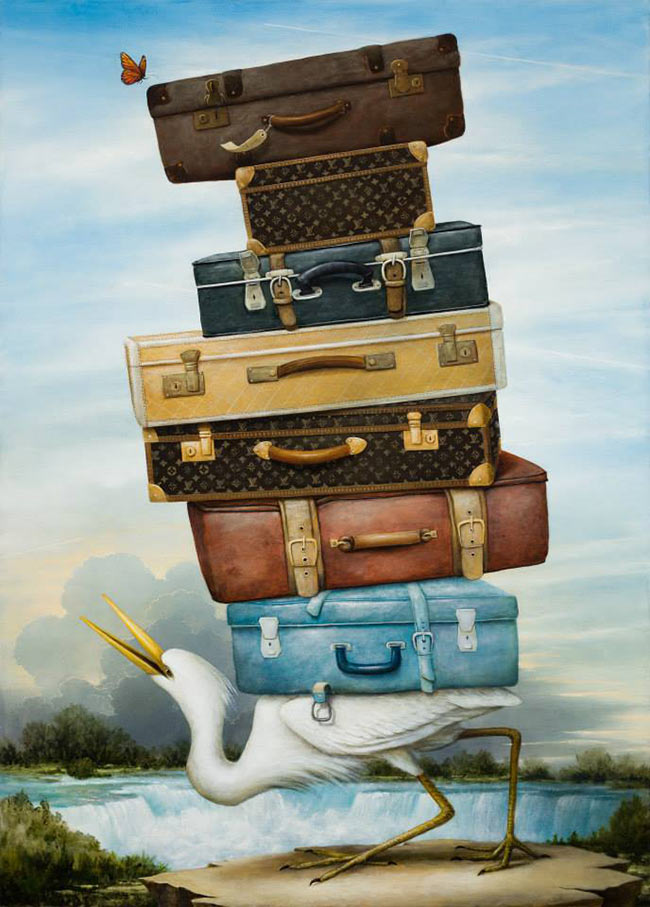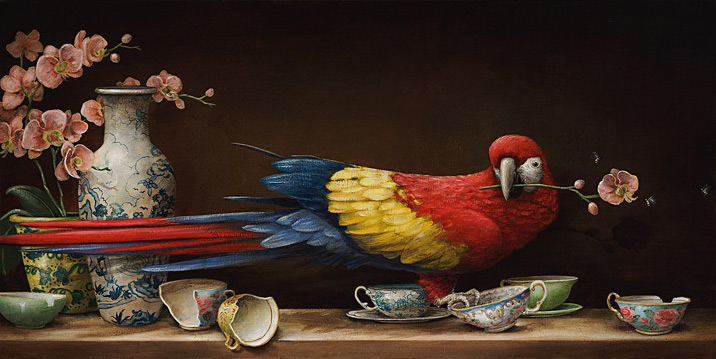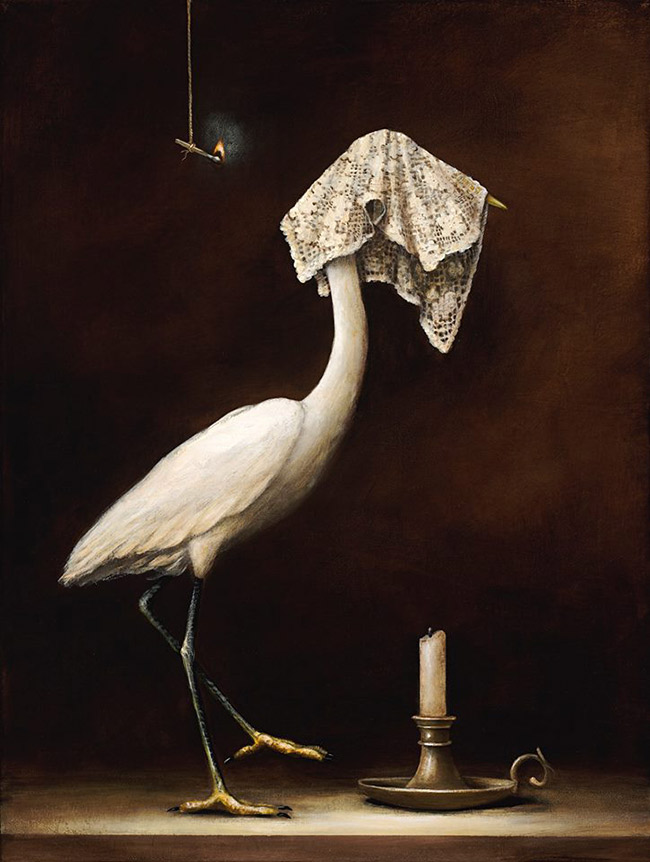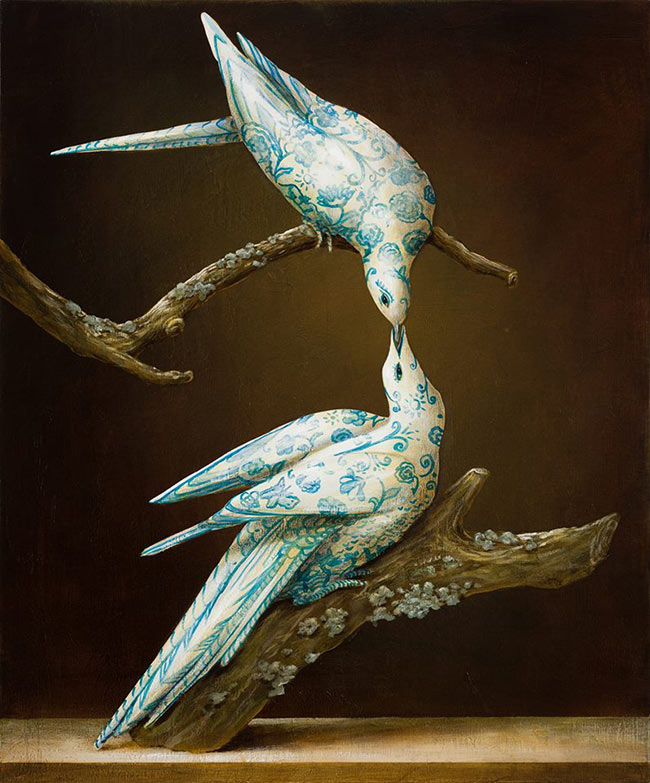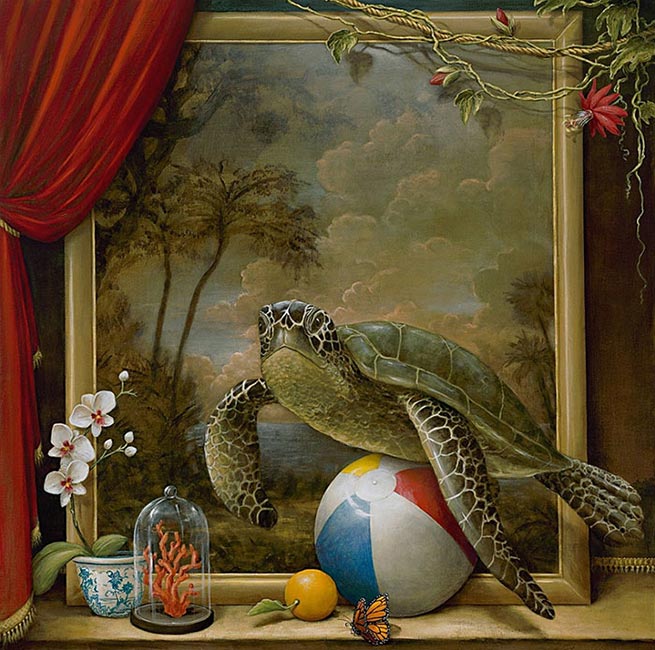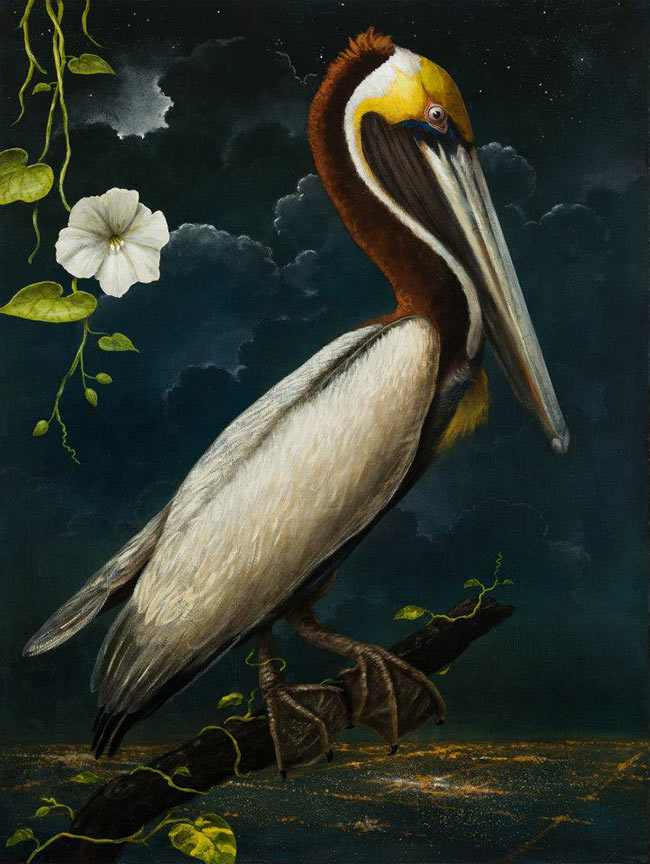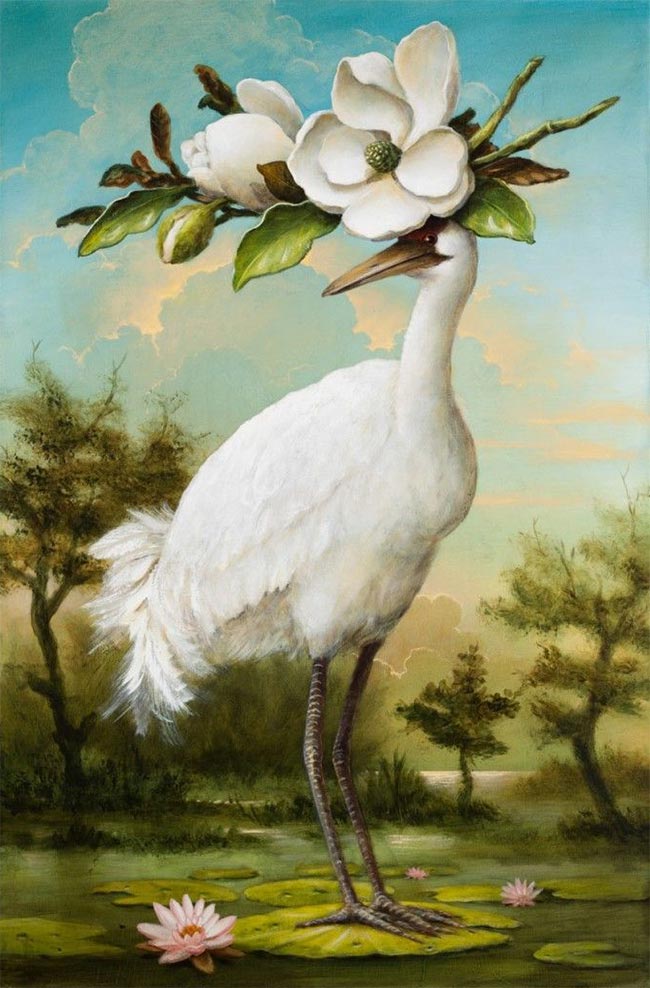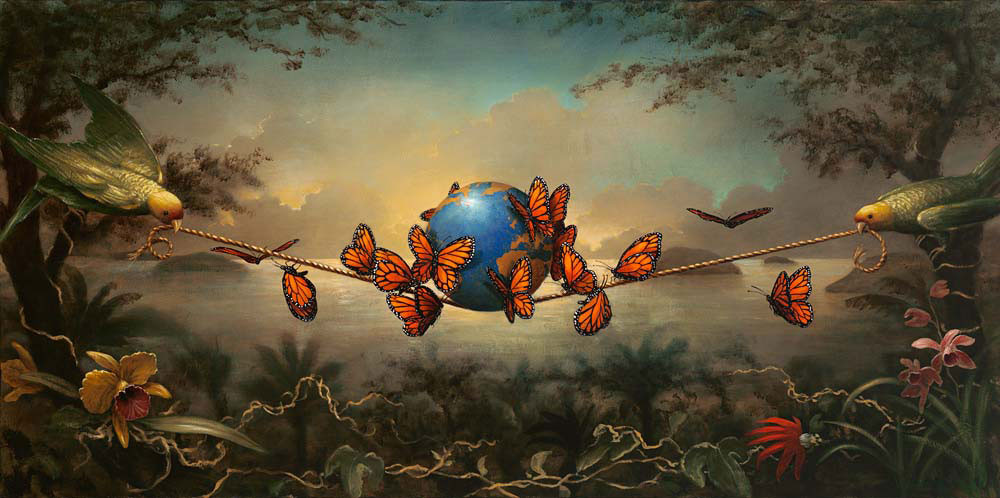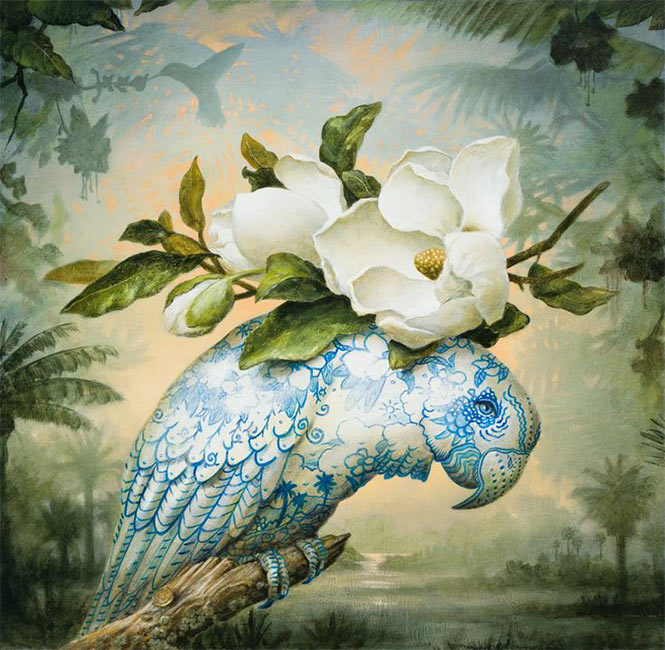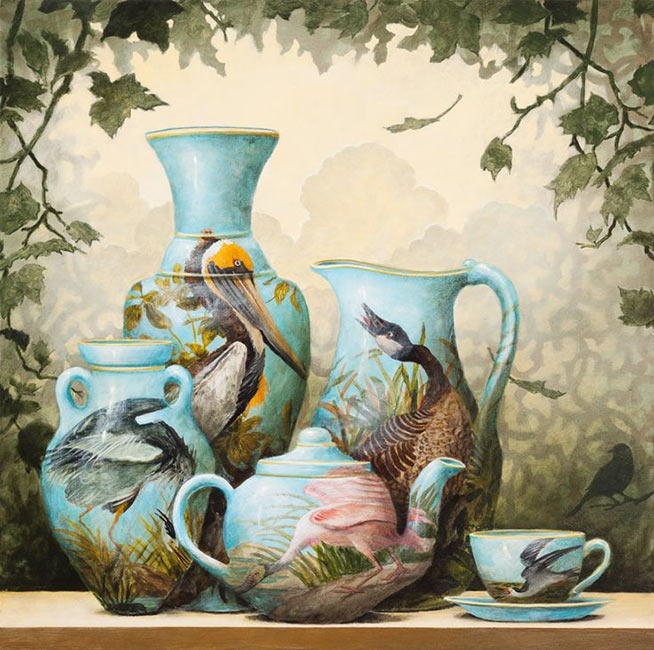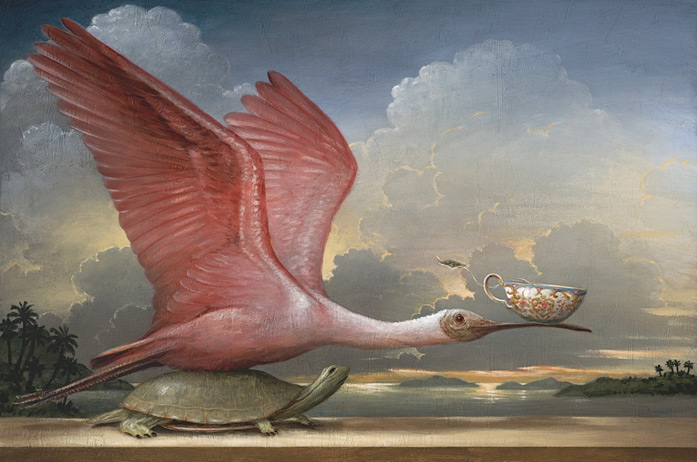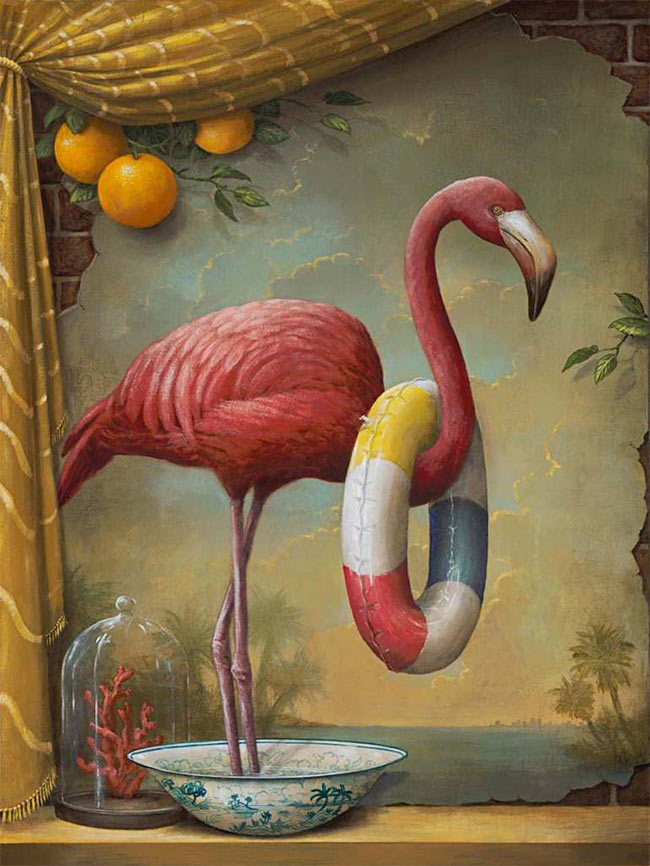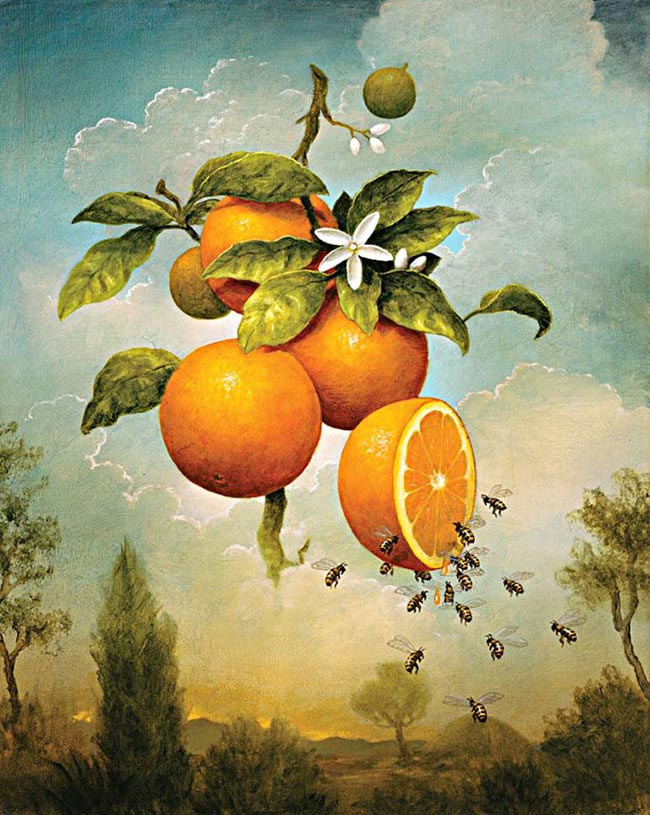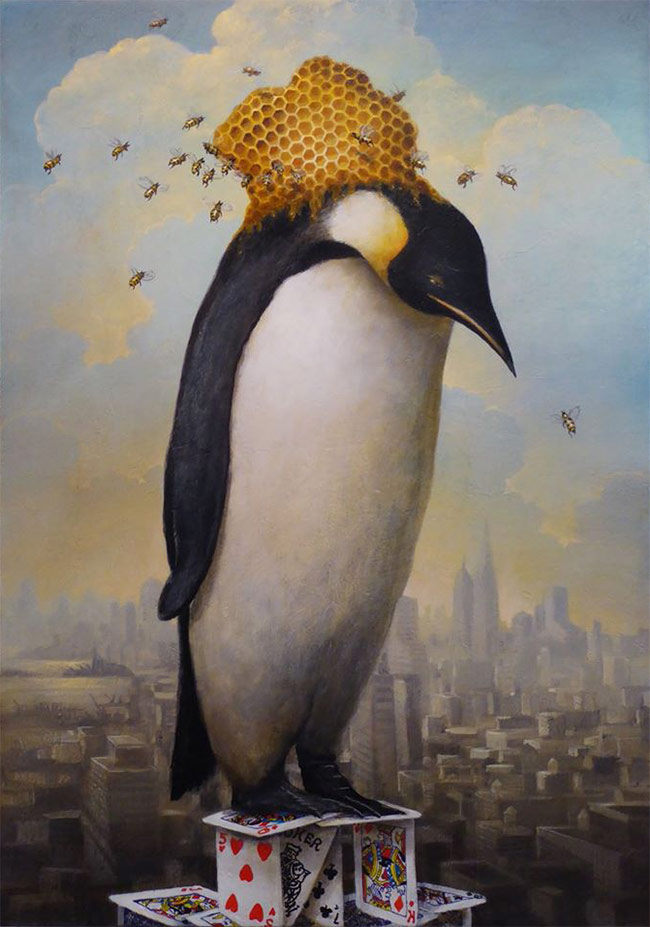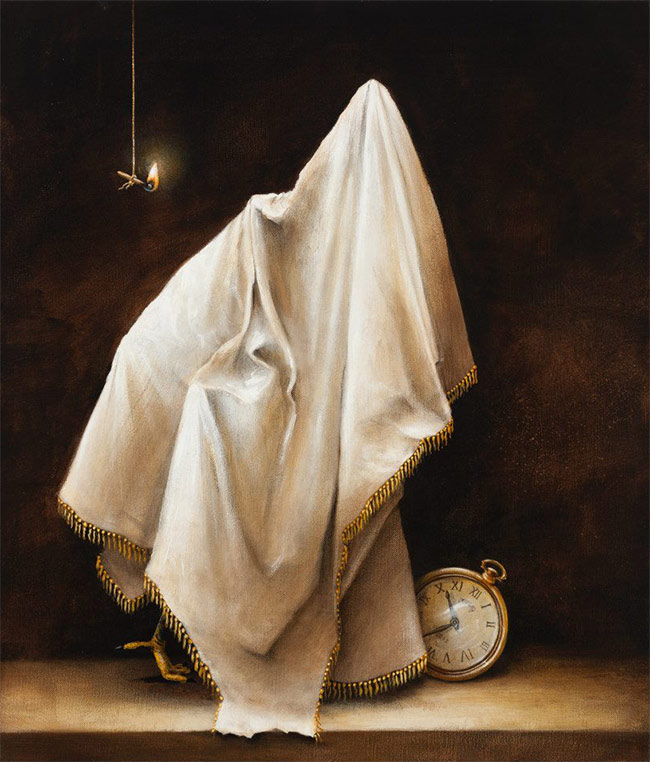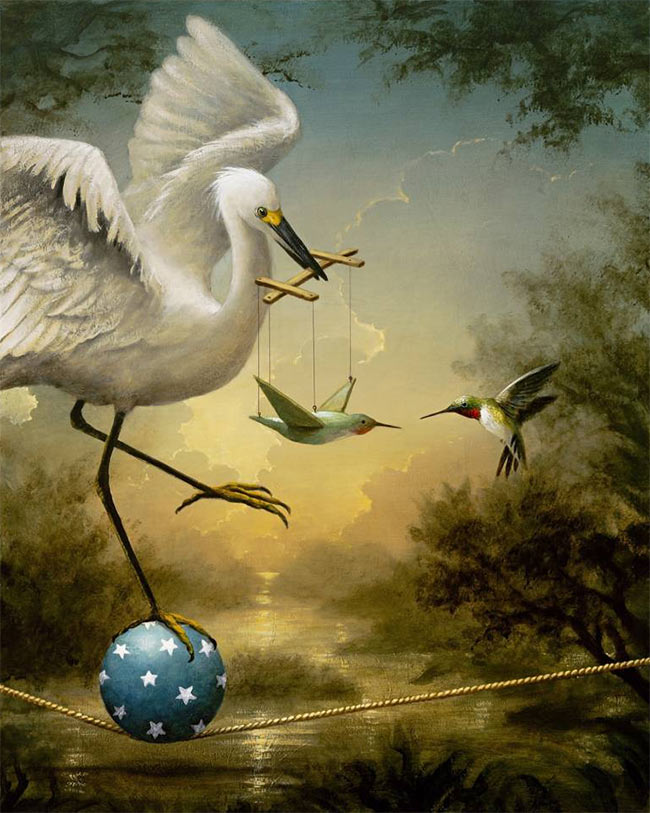Kevin Sloan’s ‘allegorical realism’ occupies a fascinating territory where the natural world and humanity’s cultural contributions collide. The deliberately awkward interchanges that occur give rise to relationships which at first may strike us as unbalanced, although on closer inspection display a nebulous harmony. Conversations are opened concerning how we interact with nature and the implications of our technological advancements on the environment we share with the rest of the animal kingdom. Sloan masterfully utilises a broad swathe of universal, contemporary and personal symbolism in the construction of his narratives, thus allowing our own intellect and experience the freedom to extract relevant meaning from the beautiful mysteries on display.
Kevin Sloan was born in Des Moine, Iowa and currently lives and work in Denver, Colorado. Kevin received a Bachelor of Fine Arts in Painting in 1981 from Tyler School of Art of Temple University, Philadelphia, PA. He then went on to study for his Master of Fine Arts at the University of Arizona, Tucson, which he was awarded in 1984. Kevin has since built up a huge following of patrons, has exhibited his work in countless galleries, in both solo and group exhibits and has had his work published in numerous publications.
WOW x WOW is honoured to be able to bring you the following exclusive interview with Kevin, in which he candidly discusses the early life experiences that inspired his respect and love of nature, his relationship with symbolism and what the future holds for him. Read on!
Hi Kevin! First of all, thanks for agreeing to free up some of your valuable time in order to have this wee chat, we really appreciate it. If you could please start us off by introducing yourself and talking about your background, touching on anything you feel has been relevant to shaping Kevin Sloan the artist?
Hi Tim! I’m so pleased to speak with you and your audience about my work. My journey as an artist began in late elementary school and really got going in high school. I quickly realized this was what I wanted to pursue in college and went on to major in art. I ultimately got a Master’s Degree in Painting. But, in addition to my formal education, I’ve been able to live in numerous and diverse locations all over the United States. The list is long – born and raised in Des Moines, Iowa, then Philadelphia, PA, Tucson, AZ, San Francisco, CA, New Orleans, Louisiana, New York, NY, Key West, Florida, Santa Fe, New Mexico and now finally Denver, Colorado. These very different climates, cultures and geographies have had a profound effect on my work.
We’re interested to hear more about Denver and what you like about the area? What is the art scene like there and do you feel a part of that community?
My partner and I moved here about 3-1/2 years ago from Santa Fe, New Mexico where we’d lived for about 12 years. Denver is a very quickly growing and vibrant city. While it is going through some challenging growing pains there is also a lot of energy, especially in the art community. I’ve lived all over the United States and have never lived in a place with so many artist-run cooperative galleries and small, progressive galleries. For a city its size, I find the amount of good quality and ambitious art to be very high. Also, because Denver is attractive to many young people, the art scene is more adventurous and risk taking than a place like Santa Fe. Though I’ve only lived here a relatively short time I’ve felt very welcomed into this community. Artists here are open and willing to share; I don’t feel any sense of competition. Rather, it’s more like we’re all in this together so let’s work together to make things happen.
In what ways did your childhood and upbringing affect your relationship with the arts?
The death of my very close friend when we were both 15 years old was very traumatic and I found that my time spent in art class or even just doodling in my sketchbook was soothing and therapeutic. I think that period allowed me to appreciate the power of image making and I gratefully had a very supportive group of teachers as well as my parents who allowed me to pursue my fledgling art career. My family is not artistic in the traditional sense, so the idea of being an artist was very foreign to them. But, they recognized my talent and in high school allowed me to take classes at the museum in Des Moines, Iowa where we lived. This experience opened up the art world to me in ways that most kids that age never get. Not only did I have access to upper level adult classes, I was able to study with practicing, professional artists on a weekly basis. Additionally, I had an extraordinary collection of contemporary art within the museum at my disposal.
Once you have an idea for a painting, what’s next? What do you use in the way of reference material and how do you go about sourcing it? If you could give us some insight into how you tackle the creative process?
Ideas generally start with a very simple image, a phrase or even just a word I come across. I’m constantly writing these fleeting impressions down so I don’t forget them. Some will continue to tickle my attention and I’ll realize this idea is asking for my attention so I try to honour that and see what we can do together. The next step may involve writing some notes and maybe more little sketches to learn more about how this might come to life as a painting. By then I will have also determined what size and shape canvas is appropriate and once it’s prepared I will start drawing with very soft charcoal. This process can take hours or even days. Once I feel I have a good place to begin I will start with paint – usually very thin washes of acrylic paint. At this point things are still very much up in the air and I continue to draw on the canvas to make adjustments. This process continues but with the decisions becoming more committed and refined. I use imagery I find from numerous sources. I take photographs, find images online, and look through a variety of magazines and books ranging from fashion advertising, fine art, and natural sciences. Also, many times one painting will be the genesis of the idea for the following one. I often see something in the piece I’m working on that is worth more attention but to be pursued in the next painting. In this way, I feel like I’m working in series and when working toward an exhibit this tendency is very helpful in creating a cohesive body of work.
Storytelling and narrative, and in particular allegorical narrative, are at the heart of your creative process. What is it about allegory that you find lends itself best to aiding you in relaying your messages and can you tell us about some of the examples of allegory that piqued your interest early on? Also, what do you feel are some of the most important ingredients that go into making a successful visual narrative?
I was raised in a traditional Catholic family and going to Catholic school for 12 years meant going to Mass nearly every day. As tedious as that usually was, I was also very attracted to the rituals and symbolism. I was fascinated by the idea that an object while appearing to be one thing – bread, wine, etc. was also believed to actually be something else. Additionally, the scriptures were one allegorical story after another. In other words, the physical world was only the vessel for a larger and more profound spiritual reality. As a child this can be quite magical and I think had an influence on me. While I no longer believe in those rituals and beliefs, I took away the understanding that one thing could represent something else and perhaps in doing so, point to a larger and deeper understanding of the world. I feel that the best stories (paintings) are ones that rely on the known, natural world. This way, the viewer begins their relationship with the story at a place of understanding. Then, if successfully crafted, the artist can slightly re-arrange and tweak what is known in order to point to the underlying message. Simple depiction of the seen world in art is fine but ultimately risks becoming dull and predictable. It often only takes a slight adjustment of “reality” to create a compelling allegorical narrative. Too much, and it becomes fantasy. To delicately walk the line between “reality” and fantasy is where the best allegorical stories lie.
So, how are you currently approaching the symbolic aspects of your art?
As an art student I was drawn to the symbolism so prevalent in Western Art from early Egyptian, Greek and Roman art to the great paintings of the Medieval and Renaissance eras. Because most people in history couldn’t read, the art of their time was instructive and a visual, and a symbolic language was developed. People in the past knew how to “read” a painting’s meaning via the symbolic imagery it contained. I mourn the loss of our ability to do this! Nevertheless, I still believe that there is great power in a visual, symbolic language and I strive to create paintings that convey a story or a sensation via symbolism. For example, when I paint a house of cards, this is symbolic of an unstable and unsustainable structure or idea. Our culture generally understands this symbol so it can be used and most often understood. I also try to create new symbols, like when I use an orange industrial electrical extension cord. When this cord is interacting with an animal I see it as a symbol of entanglement and the risks to the natural world associated with our need for electrical power. Not all people “get” this but it’s an interesting challenge for me as a storyteller.
The animal kingdom is one of your biggest sources of inspiration and birds feature frequently in your work. What are some of the earliest memories you have, which contributed to forming the foundation of your life-long passion for, and interest in wildlife and the symbolism it carries?
When I was young, there was an area near our home that had yet to be developed. We lived in a new, suburban development but it had only gone so far and the street abruptly ended. We called this place “The End of the Street”. My friend and I would spent countless hours there exploring in what we later learned were the remains of a former farm. No structures remained but fruit trees, rhubarb plants, asparagus and other garden plants gone wild, as well as a small stream and all the wildlife you’d expect in an area like this. In this semi-wild place, I was able to interact with nature in an unstructured way and being free to play in this way I learned to respect and treasure the natural world. I also see the natural world as our silent companions on this Earth. I feel it’s important to give these creatures a voice, or at least acknowledge them. The birds and other creatures in our world can be powerful symbols of the untamed, free, and now sadly, threatened parts of our own existence as human beings.
Do you always feel that you have a comprehensive understanding of your imagery before you paint it, or have there been any occasions where an image has revealed something to you after its completion? If so we’d love to hear about it.
Some paintings are very clear and come to life quickly and almost effortlessly. It’s almost like watching a photograph slowly appear on the paper in the darkness of a photographic darkroom. It’s like the image was always there and I simply had to assist it in becoming realized. More often though, the imagery starts with a small seed of an idea and grows as the painting progresses. This growth can be rather erratic and occasionally frustrating but it is essential if the painting is to be true. Sometimes, often years later I will look at a picture of one of my paintings and realize that while the symbolic and allegorical story I was telling is intact, it was also a clear description of my own personal journey at the time. I suppose this is more often true than not, but I’m not always aware of it. I find that very interesting; the idea that I can create an image is simultaneously internal and external.
What do you feel is the most essential factor an artist must be open to, regarding the evolution of their practice? Having had a lengthy and successful career so far, how have you seen your own work evolve over time?
We are all changing, all the time. We move, relationships change, incomes go up and down, we get ill, all these things are constantly changing and influencing our lives. I believe it’s helpful to allow these life changes to affect one’s art. The art need not be specifically about these changes but if an artist is being true to oneself, then it’s inevitable that these life events become evident in the work, however subtly. My work has evolved considerably over time and yet, I believe it has always been uniquely mine. I have tried to be open to the little voice inside that prompts me to look at something a little longer or when I feel uncomfortable about something I’ve just seen or heard, ask myself why it’s bothering me so much. It’s those things; that voice of the Muse that must be honoured if the work is to grow and evolve as one’s life grows and evolves. When I’ve moved to a new locale I will eventually be challenged to incorporate something of that place into my work. Sometimes I will resist and say to myself “I don’t do that” when what I’m really feeling is “I’m a little afraid of that because it’s new and what will people think?” Post graduate school, my work was nearly abstract and over time developed into more and more recognizable imagery. When I started incorporating animals my galleries were very unsure and afraid. Collectors didn’t know what to make of it. But, managing other people’s expectations of your work is a tricky and dangerous business. Fear of their negative assessment is an on-going challenge for most creative people, but that tension is an essential part of the creative process. As David Bowie said: “There is no progress without failure. And each failure is a lesson learned. Unnecessary failures are the ones where an artist tries to second guess an audience’s taste, and little comes out of that situation except a kind of inward humiliation.”
Do the interpretations viewers offer about your work ever end up influencing what you produce? What are your thoughts about the dialogue and conversation cycle which is created between the artist and viewer?
I love to hear what viewers think of my work. Often, it’s so far from my intention that I wonder if we’re talking about the same painting! I love that a single, static image can be some many different things to so many different people.I take all this in and really try to listen and learn from it. Whether it consciously affects my decision making, I can’t say for sure. There is another kind of interpretation that usually comes from the purchasing, viewing public. I sometimes hear of their comments via my galleries and this can be very challenging information. Galleries are in the business of selling your art so this feedback is part of their day-to-day experience. Comments from their customers can be challenging because it can take the form of things like “we don’t like the fire in the background” or, “is that turtle sad?”, or “it’s too dark” – while describing a painting about night-time! Because I am attempting to make a living from the sale of my work, it is challenging to deal with these comments and remain as true as possible to my intentions.
What would be the greatest compliment you could ever receive about your work?
When I meet someone who has owned a painting for a number of years and they tell me they still love it, and that it still gives them so much, and over the years their interpretation of it has evolved. That’s incredible to me, because so often static art like paintings can become sort of invisible and sink into the background as they hang on the wall. We live in a world filled with vivid, colourful and moving images. Paintings don’t move or change, so for someone to acknowledge the painting still resonates with them amid all the distractions out there is a very nice compliment indeed.
In order to get a better understanding of the personality of an artist, it can help to get a peek behind the curtain. Would you be willing to share a story from your own life, possibly one who’s memory you find yourself returning to for inspiration, or maybe just a tale about a hardship you’ve overcome which has helped define the person and therefore artist that you are now?
Years ago, after I’d finished Graduate School I was working part-time in a small grocery store in Tucson, Arizona. I had my fancy Master’s Degree but was working part-time in a small grocery with high school kids. It was a little demoralizing at times but I was able to keep all my creative energy intact for the evenings and days off when I’d go home and paint. During this time I entered a painting in the Arizona Biennial competition, which was sponsored by the Tucson Museum of Art. I got a large painting accepted in the show and it won an award. It was wonderful. I was then informed that an important local collector would like to buy that painting! I’d not sold anything before so this was significant on many levels. When the show was over and I’d been paid I had more money than I’d had in a very long time. I decided to invest all of it in supplies; paint, canvas and stretchers. I knew that if I had materials, there would be little excuse for me not to make art. The only thing I’d have to find was the time to do it. So, I had an incredible cache of supplies, which lasted for a couple years. I then had the freedom to learn and explore without the fear of “wasting” materials. It was one of the best decisions I’ve ever made and I still benefit from it to this day.
What’s next for Kevin Sloan?
My work continues to evolve. I’m revisiting the use of the human figure in my work. I haven’t included the figure in over 15 years, but feel compelled to work with it again. It’s challenging but also very invigorating, so I’m excited to see where this goes. I also have some tiny seeds of ideas that seem destined to be realized as sculpture, which I’ve never done before. And, this summer I will get to be a student again for a couple weeks! I will be studying with Enrique Martinez Celaya at the Anderson Ranch Arts Center here in Colorado. He’s an artist I greatly admire, so it will be an honour to spend two weeks studying with him.


